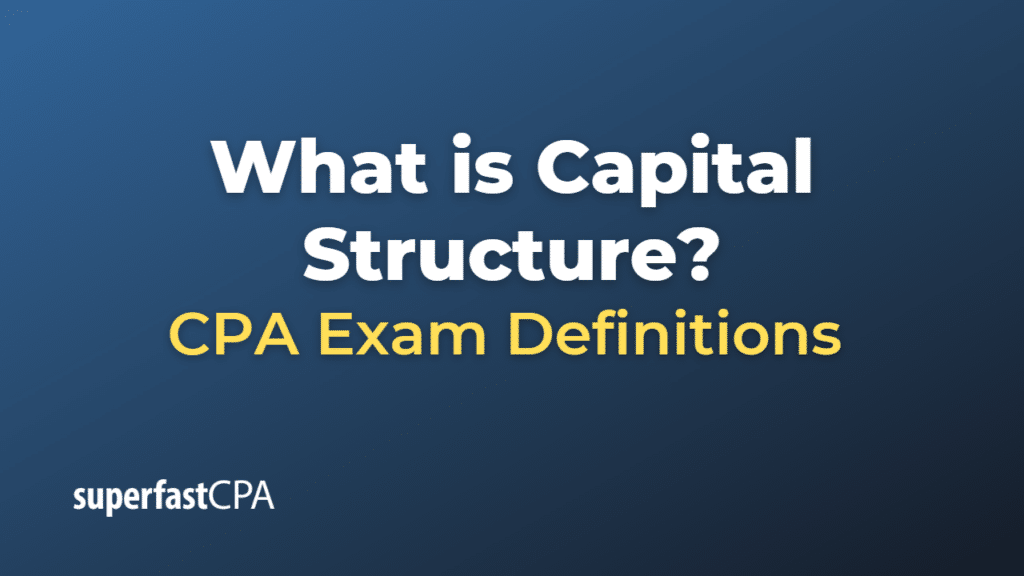Capital Structure
Capital structure refers to the mix of a company’s various sources of funding, which typically includes both debt and equity. It represents how a company finances its operations, assets, and growth by balancing the proportion of debt, such as loans or bonds, and equity, which includes common stock, preferred stock, or retained earnings. Capital structure is an important aspect of corporate finance because it influences the company’s risk profile, cost of capital, and financial flexibility.
Companies have different capital structures depending on factors such as their industry, stage of development, growth prospects, and management preferences. A company’s capital structure can have a significant impact on its financial performance, valuation, and shareholder returns.
There are several key concepts related to capital structure:
- Leverage: Leverage refers to the use of borrowed funds (debt) to finance a company’s operations, investments, or growth. Companies with a high proportion of debt in their capital structure are considered more leveraged, which can increase the potential returns to shareholders but also expose them to greater financial risk.
- Cost of capital: The cost of capital represents the weighted average cost of debt and equity financing for a company. It is a key metric used to evaluate the attractiveness of investment projects or the overall cost of funding a company’s operations. A company’s capital structure affects its cost of capital, as different sources of financing have different costs associated with them.
- Financial risk: A company’s capital structure can influence its financial risk, which refers to the risk associated with its ability to meet its financial obligations, such as interest payments on debt or dividend payments to shareholders. Companies with a higher proportion of debt in their capital structure face greater financial risk, as they must meet fixed interest payments regardless of their operating performance.
- Financial flexibility: A company’s capital structure can also affect its financial flexibility, which refers to its ability to adapt to changes in its business environment or pursue new investment opportunities. Companies with lower levels of debt and a higher proportion of equity financing generally have greater financial flexibility, as they are less constrained by debt covenants and interest payments.
Ultimately, the goal of capital structure management is to find the optimal balance between debt and equity financing that maximizes shareholder value while maintaining an acceptable level of financial risk and flexibility.
Example of Capital Structure
Let’s consider two fictional companies, “AlphaTech Inc.” and “BetaSoft Inc.,” to illustrate how different capital structures can impact their risk profile and financial performance.
Both companies operate in the technology industry and have similar market capitalizations and growth prospects. However, their capital structures differ significantly:
- AlphaTech Inc. has a conservative capital structure with a low level of debt. The company’s financing consists of 90% equity (from common stock and retained earnings) and 10% debt (from loans and bonds).
- BetaSoft Inc. has a more aggressive capital structure with a higher level of debt. The company’s financing consists of 60% equity (from common stock and retained earnings) and 40% debt (from loans and bonds).
These different capital structures have several implications for the two companies:
- Leverage: BetaSoft has a higher level of leverage compared to AlphaTech, as it relies more heavily on debt financing. This means that BetaSoft’s potential returns to shareholders could be higher if the company performs well, but it also faces greater financial risk if its performance declines.
- Cost of capital: AlphaTech’s cost of capital is likely to be higher than BetaSoft’s, as equity financing is generally more expensive than debt financing. However, this higher cost of capital may be offset by a lower level of financial risk due to the company’s conservative capital structure.
- Financial risk: BetaSoft faces greater financial risk compared to AlphaTech, as it must meet larger interest payments on its debt regardless of its operating performance. This increased financial risk could make BetaSoft more vulnerable to economic downturns or changes in its business environment.
- Financial flexibility: AlphaTech has greater financial flexibility than BetaSoft, as it is less constrained by debt covenants and interest payments. This could allow AlphaTech to more easily adapt to changes in its business environment or pursue new investment opportunities.
In this example, AlphaTech and BetaSoft illustrate how different capital structures can impact a company’s risk profile, cost of capital, and financial performance. The optimal capital structure for each company will depend on factors such as its industry, growth prospects, management preferences, and overall risk tolerance.













